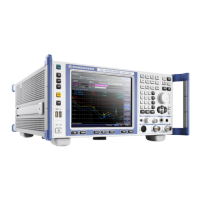Spectrum Measurements
R&S
®
ESR
394User Manual 1175.7068.02 ─ 12
This averaging method only takes effect if the grid is set to a logarithmic scale
("Range" softkey), i.e. the unit of the data is dBm. In this case the values are averaged
in dBm. Otherwise (i.e. with linear scaling), the behavior is the same as with linear
averaging (see Lin softkey). For further information on logarithmic scaling refer to the
"Average Mode" softkey.
Remote command:
SENS:AVER1:TYPE VID, see [SENSe:]AVERage<n>:TYPE on page 852
Power ← Average Mode
Activates linear power averaging.
The power level values are converted into unit Watt prior to averaging. After the aver-
aging, the data is converted back into its original unit.
Unlike the linear mode, the averaging is always done in W.
Remote command:
SENS:AVER1:TYPE POW, see [SENSe:]AVERage<n>:TYPE on page 852
Trace Math
Opens the "Trace Mathematics" dialog box to define which trace is subtracted from
trace 1. The result is displayed in trace 1 and refers to the zero point defined with the
Trace Math Position softkey. The following subtractions can be performed:
"T1"->"T1"-"T2" Subtracts trace 2 from trace 1.
"T1"->"T1"-"T3" Subtracts trace 3 from trace 1
"T1"->"T1"-"T4" Subtracts trace 4 from trace 1
"T1"->"T1"-"T5" Subtracts trace 5 from trace 1
"T1"->"T1"-"T6" Subtracts trace 6 from trace 1
To switch off the trace math, use the Trace Math Off softkey.
Remote command:
CALCulate<n>:MATH[:EXPression][:DEFine] on page 847
CALCulate<n>:MATH:STATe on page 848
Trace Math Mode
Opens a submenu to select the mode for the trace math calculations.
Lin ← Trace Math Mode
Activates linear subtraction, which means that the power level values are converted
into linear units prior to subtraction. After the subtraction, the data is converted back
into its original unit.
This softkey takes effect if the grid is set to a linear scale (see Range softkey). In this
case, subtraction is done in two ways (depending on the set unit – see Unit softkey):
●
The unit is set to either W or dBm: the data is converted into W prior to subtraction,
i.e. averaging is done in W.
●
The unit is set to either V, A, dBmV, dBµV, dBµA or dBpW: the data is converted
into V prior to subtraction, i.e. subtraction is done in V.
Analysis

